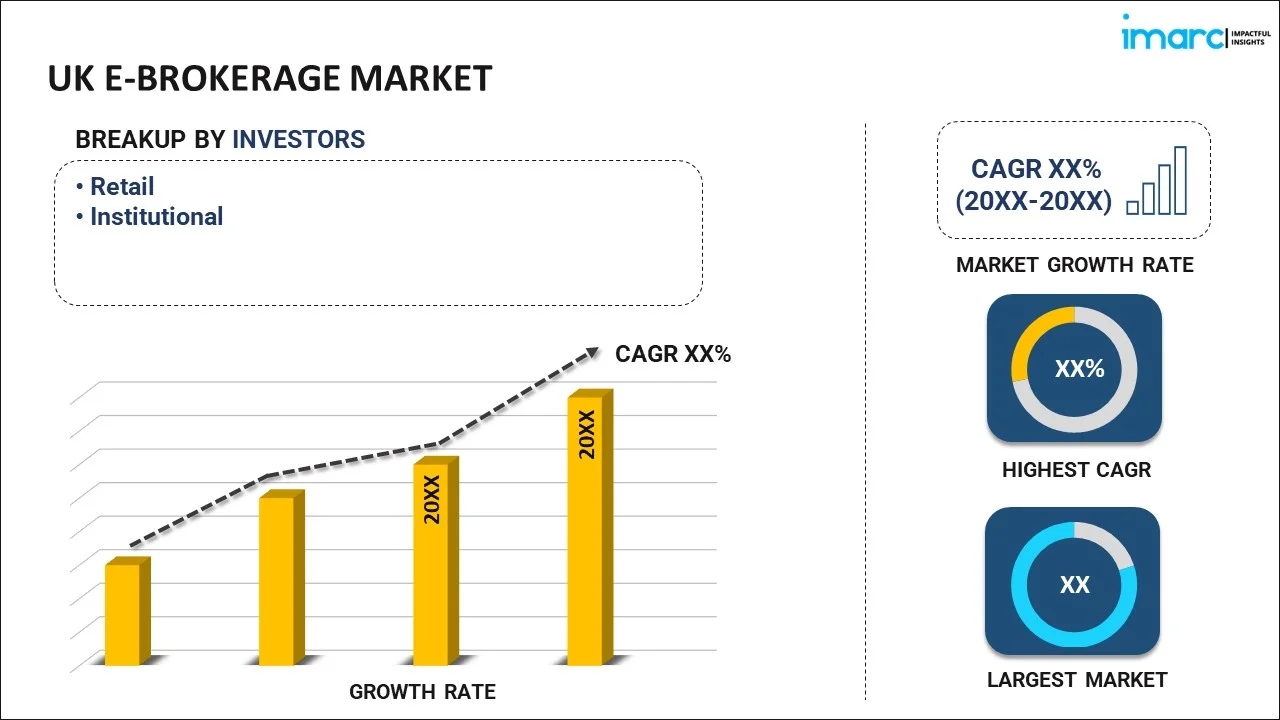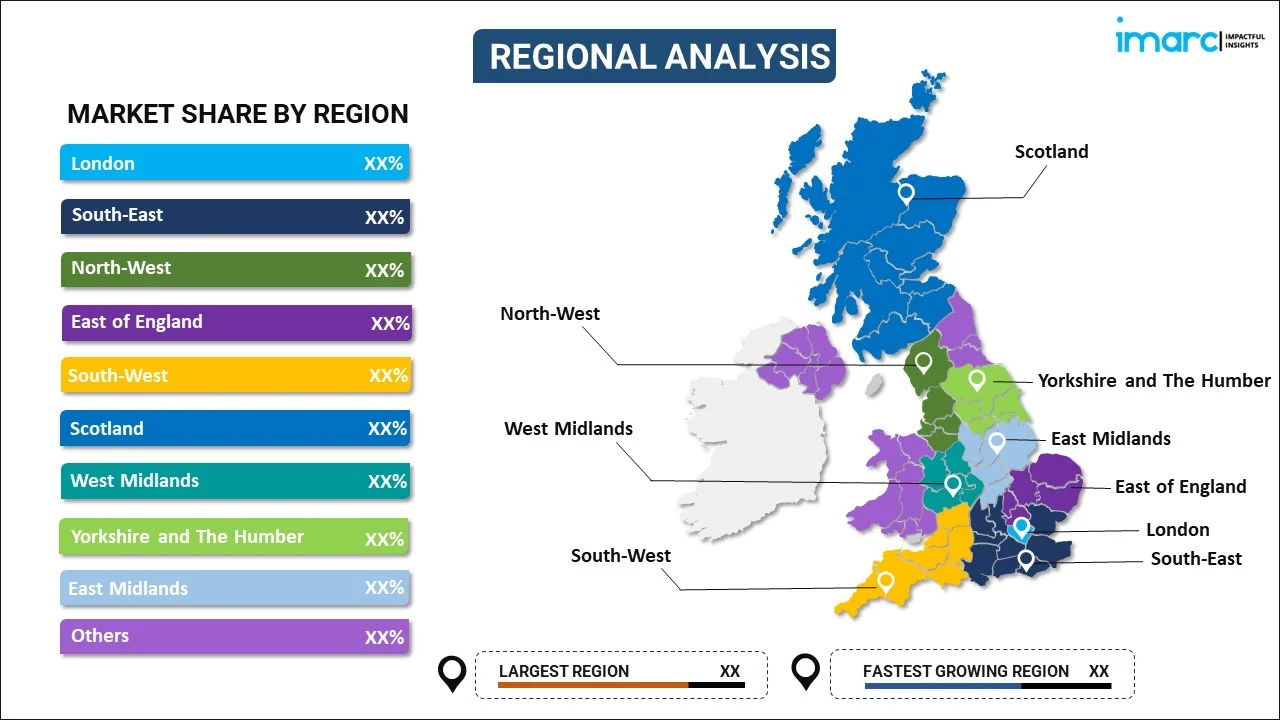
UK E-Brokerage Market Report by Investor (Retail, Institutional), Operation (Domestic, Foreign), and Region 2025-2033
Market Overview:
UK e-brokerage market size is projected to exhibit a growth rate (CAGR) of 2.9% during 2025-2033. The continuous advancements in technology, particularly in areas like artificial intelligence, machine learning, and blockchain, which can enhance the efficiency and capabilities of e-brokerage platforms, are primarily driving the regional market.
|
Report Attribute
|
Key Statistics
|
|---|---|
|
Base Year
|
2024 |
|
Forecast Years
|
2025-2033 |
|
Historical Years
|
2019-2024
|
| Market Growth Rate (2025-2033) | 2.9% |
E-brokerage, short for electronic brokerage, refers to the online platform that facilitates the buying and selling of financial securities, such as stocks, bonds, and mutual funds. This digital evolution of traditional brokerage services allows investors to execute trades, monitor market trends, and manage their investment portfolios through internet-based platforms. E-brokerage platforms often provide real-time market information, research tools, and customizable features, empowering users with greater control and accessibility to financial markets. The shift to e-brokerage has democratized investing by enabling individuals to participate in the financial markets with ease, offering a more cost-effective and efficient alternative to traditional brick-and-mortar brokerages. The convenience, speed, and accessibility of e-brokerage have contributed to its widespread adoption, transforming the landscape of financial trading.
UK E-Brokerage Market Trends:
The e-brokerage market in the UK is thriving, fueled by several key drivers that have reshaped the landscape of financial services. Firstly, the rapid digitization of the regional economy has significantly contributed to the growth of e-brokerage platforms. As consumers increasingly embrace online transactions and digital solutions, the demand for convenient and accessible investment platforms has surged. Moreover, the widespread availability of high-speed internet and advancements in technology have empowered investors with real-time data and seamless trading experiences. Additionally, the rise of mobile technology has played a pivotal role in driving the e-brokerage market forward. With the majority of investors now accessing financial markets through their smartphones, e-brokerage platforms have adapted to cater to the mobile-centric preferences of users. Furthermore, the democratization of financial markets, facilitated by e-brokerage services, has attracted a broader and more diverse investor base. This inclusivity has not only expanded the market but has also democratized access to investment opportunities. Furthermore, the accelerated adoption of e-brokerage platforms, as lockdowns and social distancing measures prompted individuals to explore online investment options, is also propelling the market growth. In conclusion, the e-brokerage market in the UK is propelled by a confluence of factors, ranging from technological advancements to shifts in consumer behavior, making it a dynamic and rapidly evolving sector.
UK E-Brokerage Market Segmentation:
IMARC Group provides an analysis of the key trends in each segment of the market, along with forecasts at the country level for 2025-2033. Our report has categorized the market based on investor and operation.
Investor Insights:

- Retail
- Institutional
The report has provided a detailed breakup and analysis of the market based on the investor. This includes retail and institutional.
Operation Insights:
- Domestic
- Foreign
A detailed breakup and analysis of the market based on the operation have also been provided in the report. This includes domestic and foreign.
Regional Insights:

- London
- South East
- North West
- East of England
- South West
- Scotland
- West Midlands
- Yorkshire and The Humber
- East Midlands
- Others
The report has also provided a comprehensive analysis of all the major regional markets, which include London, South East, North West, East of England, South West, Scotland, West Midlands, Yorkshire and The Humber, East Midlands, and Others.
Competitive Landscape:
The market research report has also provided a comprehensive analysis of the competitive landscape. Competitive analysis such as market structure, key player positioning, top winning strategies, competitive dashboard, and company evaluation quadrant has been covered in the report. Also, detailed profiles of all major companies have been provided.
UK E-Brokerage Market Report Coverage:
| Report Features | Details |
|---|---|
| Base Year of the Analysis | 2024 |
| Historical Period | 2019-2024 |
| Forecast Period | 2025-2033 |
| Units | Million USD |
| Scope of the Report | Exploration of Historical Trends and Market Outlook, Industry Catalysts and Challenges, Segment-Wise Historical and Future Market Assessment:
|
| Investors Covered | Retail, Institutional |
| Operations Covered | Domestic, Foreign |
| Regions Covered | London, South East, North West, East of England, South West, Scotland, West Midlands, Yorkshire and The Humber, East Midlands, Others |
| Customization Scope | 10% Free Customization |
| Post-Sale Analyst Support | 10-12 Weeks |
| Delivery Format | PDF and Excel through Email (We can also provide the editable version of the report in PPT/Word format on special request) |
Key Questions Answered in This Report:
- How has the UK e-brokerage market performed so far and how will it perform in the coming years?
- What has been the impact of COVID-19 on the UK e-brokerage market?
- What is the breakup of the UK e-brokerage market on the basis of investor?
- What is the breakup of the UK e-brokerage market on the basis of operation?
- What are the various stages in the value chain of the UK e-brokerage market?
- What are the key driving factors and challenges in the UK e-brokerage?
- What is the structure of the UK e-brokerage market and who are the key players?
- What is the degree of competition in the UK e-brokerage market?
Key Benefits for Stakeholders:
- IMARC’s industry report offers a comprehensive quantitative analysis of various market segments, historical and current market trends, market forecasts, and dynamics of the UK e-brokerage market from 2019-2033.
- The research report provides the latest information on the market drivers, challenges, and opportunities in the UK e-brokerage market.
- Porter's five forces analysis assist stakeholders in assessing the impact of new entrants, competitive rivalry, supplier power, buyer power, and the threat of substitution. It helps stakeholders to analyze the level of competition within the UK e-brokerage industry and its attractiveness.
- Competitive landscape allows stakeholders to understand their competitive environment and provides an insight into the current positions of key players in the market.
Need more help?
- Speak to our experienced analysts for insights on the current market scenarios.
- Include additional segments and countries to customize the report as per your requirement.
- Gain an unparalleled competitive advantage in your domain by understanding how to utilize the report and positively impacting your operations and revenue.
- For further assistance, please connect with our analysts.
 Inquire Before Buying
Inquire Before Buying
 Speak to an Analyst
Speak to an Analyst
 Request Brochure
Request Brochure
 Request Customization
Request Customization




.webp)




.webp)












